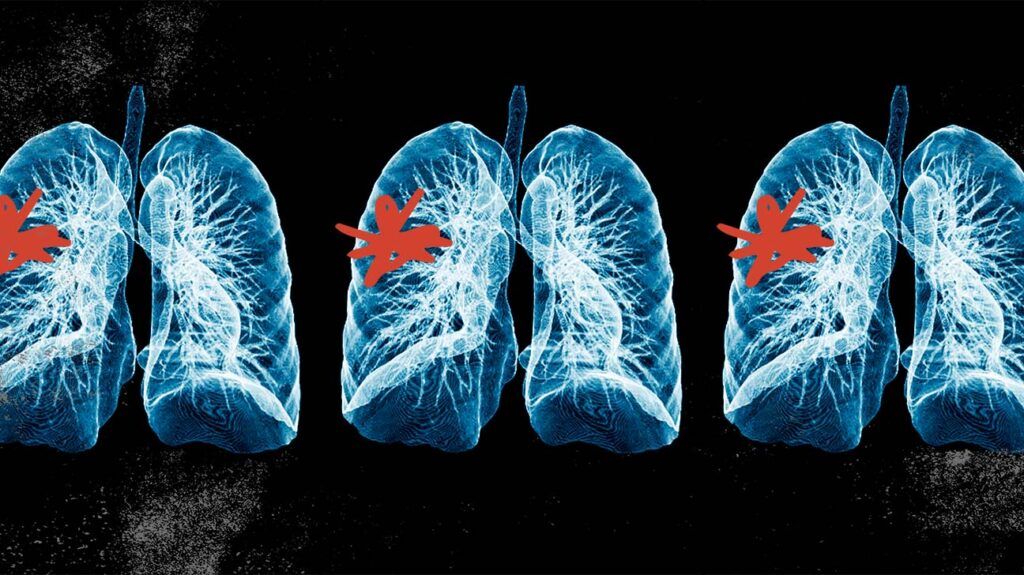- Researchers report that as many as 70% of people with chronic obstructive pulmonary disease (COPD) or asthma could be undiagnosed.
- They say that receiving a diagnosis and treatment can dramatically improve health and quality of life for a person with one of those conditions.
- They add the people should take respiratory symptoms seriously and consult a physician and request a spirometry test if they’re concerned.
Next time you go to the doctor, maybe ask them to check your breathing — especially if you’ve been experiencing even minor trouble.
Nearly seven out of 10 people with asthma or chronic obstructive pulmonary disease (COPD) are undiagnosed, a situation that can lead to worse long-term health outcomes and lower quality of life than if a person had received diagnosis and treatment earlier, a new study published in the New England Journal of Medicine reports.
This research is the first of its kind to look at not only rates of diagnosis for asthma and COPD but also to detail the effects of early treatment and diagnosis on quality of life and health system burden.
“I’m a practicing pulmonologist and I see a lot of people who come to my office who’ve experienced symptoms of asthma or COPD for months to years, and the diagnosis hasn’t been made,” Dr. Shawn Aaron, a lead study author as well as a respirologist and senior scientist at the Ottawa Hospital Research Institute and a professor at the University of Ottawa in Canada, told Medical News Today.
“So we did this study where we looked at people who were who we diagnosed with no previous history of asthma or COPD and we diagnosed them,” he explained. “We found that compared to people their age, those who are undiagnosed with COPD or asthma have a much worse quality of life. They have impaired work performance and impaired work attendance because they’re taking days off because of their respiratory symptoms. These are people that are suffering sort of silently because they’re not they’re either not seeing their doctors or their doctors are not doing the proper diagnosis.”
Researchers surveyed more than 26,000 people about shortness of breath and lung function to find a group of 595 asthma and COPD diagnoses, which were confirmed using a gold-standard spirometry test.
Of this group, 508 agreed to participate in a clinical study where half received typical clinical care for these conditions and the other half had regular visits with a lung specialist.
Both groups received help with 92% of those seeing lung specialists receiving new medications to treat the conditions as well as 60% of those who received usual care.
Those who saw lung specialists took fewer trips to the doctor in the following year (0.53 compared to 1.12 per participant) and had larger improvements on the St. George’s Respiratory Questionnaire (10 point increase compared to less than 7) when compared to their counterparts receiving usual care.
Researchers reported that both groups also improved far more than if they had remained undiagnosed. They said a four-point improvement on the respiratory questionnaire represents a significant increase in health and quality of life, which each study group experienced.
“Overall, these results are inspiring,” said Dr. Robert Jasmer, a pulmonologist at Pulmonary Associates of Burlingame in California who was not involved in the research.
“Given the specialized training and experience that we as pulmonologists have with patients who have asthma and COPD, it was nice to see the benefits of diagnosis and early treatment confirmed in a community-based study published in a prestigious medical journal,” Jasmer told Medical News Today.
On some level, the findings of this study are common sense. Of course, people with an undiagnosed medical condition do better after receiving a diagnosis.
However, beneath that is the more probing question of just why so many people go undiagnosed with serious respiratory illnesses.
The answer is multi-faceted, but one reason, especially where COPD is concerned, is that it tends to hit people later in life, which can make the symptoms easier to ignore until they progress to a state that’s undeniable, according to Aaron.
“You don’t usually start developing COPD until you’re in your sixties,” he said. “Many people who start developing COPD become more and more short of breath, and the shortness of breath is progressive, and they decline with more shortness of breath every month or two or three. Maybe they’re in denial or just figure that they’re getting older.”
Physicians can also perpetuate this dynamic.
“Sometimes the doctor will wave away the symptoms and the complaints and say, ‘Oh, yeah, well, you’re 65 now, we expect you to be a little short of breath,’” Aaron said. “Sometimes the doctor has good intentions but doesn’t make the diagnosis.”
Patient self-advocacy can help.
“If you’re experiencing prolonged cough, it doesn’t go away after eight weeks, or you’re experiencing wheezing or chest tightness — this is not normal. And you shouldn’t assume that everything is fine,” Aaron said. “You should go to your physician and you should insist on the physician ordering a spirometry test for you. What I would tell the public because we now know that if we find this and we treat it, you will get better.”
Jasmer echoed that sentiment.
“This study is important because there has been a lot of negativity for most of my education and career around COPD, especially as being an end-stage and hopeless disease for which treatment is not helpful-that is not correct, so COPD particularly suffers from a major PR problem,” he said. “Public perceptions about COPD being untreatable are not true and asthma is almost entirely treatable and usually completely reversible. While patients with COPD can help their symptoms with lifestyle changes such as quitting smoking and exercising, there are still many other effective medical treatments available that they can discuss with their doctor to further improve their symptoms, which will also improve their quality of life.”
Credit: Source link




